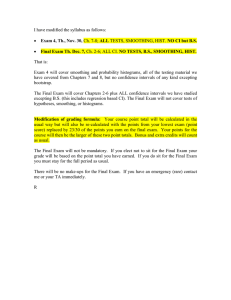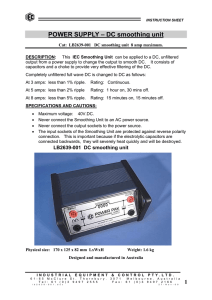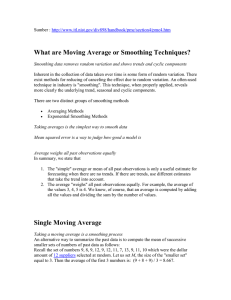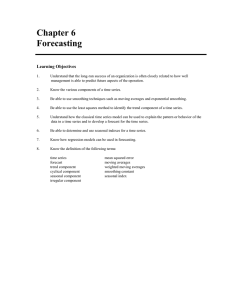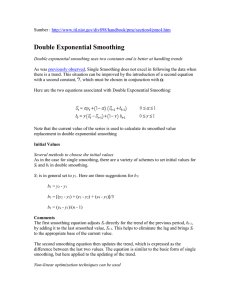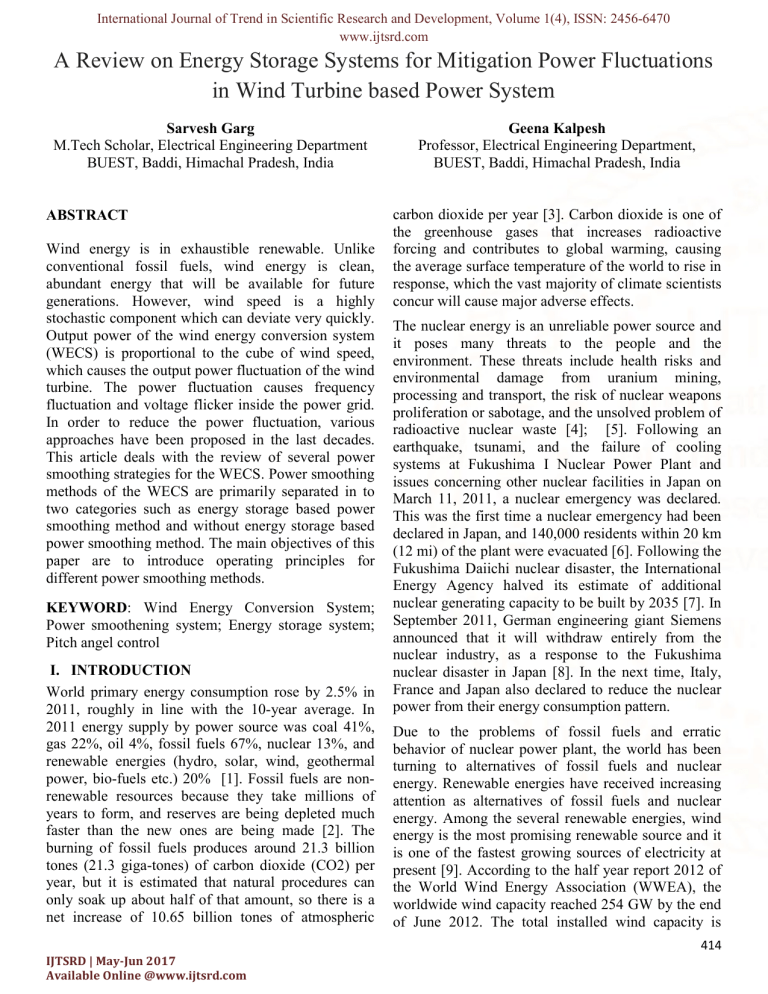
International Journal of Trend in Scientific Research and Development, Volume 1(4), ISSN: 2456-6470
www.ijtsrd.com
A Review on Energy Storage Systems for Mitigation Power Fluctuations
in Wind Turbine based Power System
Sarvesh Garg
M.Tech Scholar, Electrical Engineering Department
BUEST, Baddi, Himachal Pradesh, India
ABSTRACT
Wind energy is in exhaustible renewable. Unlike
conventional fossil fuels, wind energy is clean,
abundant energy that will be available for future
generations. However, wind speed is a highly
stochastic component which can deviate very quickly.
Output power of the wind energy conversion system
(WECS) is proportional to the cube of wind speed,
which causes the output power fluctuation of the wind
turbine. The power fluctuation causes frequency
fluctuation and voltage flicker inside the power grid.
In order to reduce the power fluctuation, various
approaches have been proposed in the last decades.
This article deals with the review of several power
smoothing strategies for the WECS. Power smoothing
methods of the WECS are primarily separated in to
two categories such as energy storage based power
smoothing method and without energy storage based
power smoothing method. The main objectives of this
paper are to introduce operating principles for
different power smoothing methods.
KEYWORD: Wind Energy Conversion System;
Power smoothening system; Energy storage system;
Pitch angel control
I. INTRODUCTION
World primary energy consumption rose by 2.5% in
2011, roughly in line with the 10-year average. In
2011 energy supply by power source was coal 41%,
gas 22%, oil 4%, fossil fuels 67%, nuclear 13%, and
renewable energies (hydro, solar, wind, geothermal
power, bio-fuels etc.) 20% [1]. Fossil fuels are nonrenewable resources because they take millions of
years to form, and reserves are being depleted much
faster than the new ones are being made [2]. The
burning of fossil fuels produces around 21.3 billion
tones (21.3 giga-tones) of carbon dioxide (CO2) per
year, but it is estimated that natural procedures can
only soak up about half of that amount, so there is a
net increase of 10.65 billion tones of atmospheric
Geena Kalpesh
Professor, Electrical Engineering Department,
BUEST, Baddi, Himachal Pradesh, India
carbon dioxide per year [3]. Carbon dioxide is one of
the greenhouse gases that increases radioactive
forcing and contributes to global warming, causing
the average surface temperature of the world to rise in
response, which the vast majority of climate scientists
concur will cause major adverse effects.
The nuclear energy is an unreliable power source and
it poses many threats to the people and the
environment. These threats include health risks and
environmental damage from uranium mining,
processing and transport, the risk of nuclear weapons
proliferation or sabotage, and the unsolved problem of
radioactive nuclear waste [4]; [5]. Following an
earthquake, tsunami, and the failure of cooling
systems at Fukushima I Nuclear Power Plant and
issues concerning other nuclear facilities in Japan on
March 11, 2011, a nuclear emergency was declared.
This was the first time a nuclear emergency had been
declared in Japan, and 140,000 residents within 20 km
(12 mi) of the plant were evacuated [6]. Following the
Fukushima Daiichi nuclear disaster, the International
Energy Agency halved its estimate of additional
nuclear generating capacity to be built by 2035 [7]. In
September 2011, German engineering giant Siemens
announced that it will withdraw entirely from the
nuclear industry, as a response to the Fukushima
nuclear disaster in Japan [8]. In the next time, Italy,
France and Japan also declared to reduce the nuclear
power from their energy consumption pattern.
Due to the problems of fossil fuels and erratic
behavior of nuclear power plant, the world has been
turning to alternatives of fossil fuels and nuclear
energy. Renewable energies have received increasing
attention as alternatives of fossil fuels and nuclear
energy. Among the several renewable energies, wind
energy is the most promising renewable source and it
is one of the fastest growing sources of electricity at
present [9]. According to the half year report 2012 of
the World Wind Energy Association (WWEA), the
worldwide wind capacity reached 254 GW by the end
of June 2012. The total installed wind capacity is
414
IJTSRD | May-Jun 2017
Available Online @www.ijtsrd.com
International Journal of Trend in Scientific Research and Development, Volume 1(4), ISSN: 2456-6470
www.ijtsrd.com
expected to reach 273 GW by the end of the year
2012 [10]. Thus, around 2.5% of global electricity
consumption has come from wind turbines. Wind is a
plentiful source available in the nature, widely
distributed, produces no emissions during operation.
In the last two decades, the wind power prospective
has been studied in many countries worldwide [11].
Though wind energy is a pollution-free and
inexhaustible source, it has some problems. Wind
energy is a fluctuating resource which can diverge
quickly. As a result, wind power is not constant and
can fluctuate significantly since wind power is
proportional to the cube of the wind speed. The
problems originated by the wind power fluctuations
are as follows [12]:
Wind power fluctuations may cause the grid
frequency to fluctuate.
The deviation in wind speed causes the
fluctuation of the active power generation and
thus the wrapped up reactive power, leading to
voltage flicker at the buses of the power grid.
Frequency fluctuation and voltage flicker
deliver a poor power quality and create
instability problems in the power system,
especially when there are loads sensitive to
accept high voltage and frequency variations.
To overcome these problems, various power
smoothing methods for the wind energy conversion
system (WECS) have been proposed in the last
decade. Based on the different power smoothing
approaches, the power smoothing methods of the
WECS can be divided into two categories-energy
storage based power smoothing method and without
energy storage based power smoothing method.
Several literatures have been proposed to generate a
smooth output power of the WECS with energy
storage devices. Installation and maintenance costs of
these devices are very high. Therefore, the recent
trends of the power smoothing methods are
considered without energy storage devices, and
proposed some approaches to reduce the power
smoothing cost of the WECS. Operating principles of
different power smoothing methods are reviewed in
this paper.
Wind Energy Conversion System
Due to the variable wind velocity, the variable speed
wind turbine (VSWT) is the most important in the
WECS because it can utilize the wind energy
proficiently. Doubly fed induction generators (DFIGs)
and permanent magnet synchronous generators
(PMSGs) based VSWTs are the most popular for the
modern wind farm. The system diagram of wind
generation system is shown in Fig. 1. The PMSG
based WECS is shown in Fig 1(a). The PMSG can
omit the gearbox. Hence, it can release all difficulties
of the gear box. Wind energy obtained from the wind
turbine is sent to the generator. The rotational speed
of the PMSG is controlled by a pulse width
modulation (PWM) converter. The output power of
the PMSG is supplied to the grid through a generatorside converter and a grid side inverter. The system
diagram of the DFIG based WECS is shown in Fig.
1(b). The stator of the DFIG is directly connected to
the grid, while a back-to-back three-phase voltage
source PWM inverter controls the rotor, which, in
turn, is connected to the grid on the other side.
Wind turbine output power, Pw, and wind turbine
torque, Tw, are given by the following equations:
1
Pw C p ( , ) R 2Vw3
2
1
V2
Tw C p ( , ) R3 w
2
where Vw is the wind speed, ρ is the air density, R is
the wind turbine blade radius, ω w is the angular speed
of the wind turbine, Cp is the power coefficient, λ is
the
tip
speed
ratio,
can
be
defined
as λ= (R o ω w )/ V w , ω w is the angular speed of the
wind turbine and β is the pitch angle.
Fig -1 Wind energy conversion system (a) PMSG
based wind turbine, (b) DFIG based wind turbine.
415
IJTSRD | May-Jun 2017
Available Online @www.ijtsrd.com
International Journal of Trend in Scientific Research and Development, Volume 1(4), ISSN: 2456-6470
www.ijtsrd.com
1.1.Energy storage based power smoothing
methods
In this subsection, power smoothing techniques of
the WECS using different energy storage devices
are described. The algorithms of the energy
storage based power smoothing methods are
almost similar to each others. Power smoothing
topologies of the ultra capacitor, battery and
SMES are identical, fuel cell and flywheel
systems are slightly different. The power
smoothing methods are described as follows.
1.1.1. Ultra capacitor, battery and SMES based
power smoothing
Fig -2 WECS output power characteristics.
The output power characteristics of the wind turbine
are depicted in Fig. 2. Here the pitch angle is β =2° .
From this figure, it can be seen that there is a
rotational speed, ω o p t , dotted by the black circles, for
any particular wind speed. ω o p t is called the optimum
rotational speed and generates the maximum
power, Pmax. In this way, the maximum power point
tracking (MPPT) control to each wind speed can
increase the power generation for the VSWTs. The
value of ω o p t is calculated by differentiating Cp with
respect to ω w .
The energy storage system i.e. ultra capacitor,
battery or SMES based power smoothing method
is shown in Fig. 4(a) and (b). Fig. 4(a) shows that
the energy storage is connected to the DC-link of
the frequency converter of the generator. This
topology does not require the bi-directional
voltage source inverter (VSI) and needs only a
buck-boost DC–DC converter to control the realpower which can reduce the system cost. But it is
quite appropriate for a stand-alone system. If this
system is applied to the wind farm which is
composed of multiple wind turbines, the energy
storage system needs to be installed at each wind
turbine and controlled for smoothing the line
power.
Power Smoothing Methods
The major categories of power smoothing methods of
the WECS are shown in Fig. 3. There are two
foremost types of power smoothing methods such as
energy storage based power smoothing methods and
without energy storage based power smoothing
methods.
Fig -3 Power smoothing methods.
Fig. 4 ESS based power smoothing. (a) ESS
connected to DC link for stand-alone system, (b)
ESS connected to wind farm terminal.
416
IJTSRD | May-Jun 2017
Available Online @www.ijtsrd.com
International Journal of Trend in Scientific Research and Development, Volume 1(4), ISSN: 2456-6470
www.ijtsrd.com
The control strategy of the each energy system will
become very complicated. Considering this fact,
relatively cost-effective topology for the power
smoothing of the wind farm is proposed in Fig. 4(b).
From this figure, the energy storage system composed
of a step down transformer, a voltage source inverter,
a DC-link capacitor and a buck-boost DC–DC
converter which is installed at the terminal of the
wind farm. When the generated power of the wind
turbine is greater than the smooth line power
reference signal, the energy storage system charges
and vice versa, which is ensured to deliver a smooth
power to the power grid.
Fuel cell based power smoothing
The fuel cell based power smoothing method is
shown in Fig. 5(a) and (b). Fig. 5(a) shows the fuel
cell with electrozer which can generate hydrogen and
stored in a tank. The stored hydrogen is used as the
fuel for the fuel cell. Fig. 5(b) shows the power
smoothing method of the reversible fuel cell.
Reversible fuel cells are designed to operate in either
water electrolysis mode or power generation mode.
For a wind-hydrogen system that stores hydrogen
energy for later conversion back to electricity,
reversible fuel cells may offer cost benefits
compared to separate units for hydrogen production
and power generation. Reversing the electrochemical
reaction within the same cell is challenging because
of the technical problems of optimizing the electrode
structure and composition.
1.1.2.
Fig. 5 Fuel cell based power smoothing. (a)
Fuel cell connected to DC link for standalone system, (b) reversible fuel cell
connected to DC link for stand-alone
system.
Flywheel based power smoothing
In a flywheel, the storage capacity is based on the
kinetic energy of a rotating disc which depends on the
square of the rotational speed. A mass rotates on two
magnetic bearings in order to decrease friction at high
speed, coupled with an electric machine. Energy is
transferred to the flywheel when the machine operates
as a motor (the flywheel accelerates), charging the
energy storage device. The FESS is discharged when
the electric machine regenerates through the drive
(slowing the flywheel). The FESS stores energy when
the wind turbine generates more power, and
discharges energy when wind turbine delivers less
power. As a result, the wind turbine generates a
smooth output power. A stand-alone FESS based
power smoothing system is shown in Fig. 6(a). From
this figure, the flywheel is connected to the wind
turbine system through a motor and a voltage source
inverter. Fig. 6(b) shows the power smoothing method
for the wind farm by using the FESS. The FESS is
connected to the wind farm terminal through a
coupling transformer, a voltage source converter, a
voltage source inverter and a motor drive. In fact, the
energy stored by the flywheel is dependent on the
square of the rotating speed and its inertia. In general,
flywheels can be classified as low speed or high speed
devices. A FESS presents suitable features regarding
high efficiency (around 90% at rated power), long
cycling life, wide operating temperature range,
freedom from depth-of-discharge effects, higher
power and higher energy density.
1.1.3.
1.2.Power smoothing methods without energy
storage devices
Power smoothing methods by using the energy
storage devices are effective, but they impose a
significant additional cost to the system.
Therefore, the power smoothing methods without
energy storage devices can reduce the system cost
extensively. In this section, different power
smoothing methods without energy storage
devices are described.
1.2.1. Power smoothing by controlling the kinetic
energy of the inertia
417
IJTSRD | May-Jun 2017
Available Online @www.ijtsrd.com
International Journal of Trend in Scientific Research and Development, Volume 1(4), ISSN: 2456-6470
www.ijtsrd.com
The basic idea is to use the energy in rotor inertia to
smooth the output power of the WECS. Since the
kinetic energy of the wind turbine inertia is
significant, it can be utilized to generate a smooth
output power as an energy storage device. The
concept behind this method depends on two events:
Increase in wind turbine kinetic energy due to the
acceleration of the turbine rotational speed when
wind speed rapidly increases.
A discharge of wind turbine kinetic energy due to
a decline in the wind turbine rotational speed
when the wind velocity drops.
can generate a smooth output power of all the
operating regions. Pitch angle controller with the
fuzzy logic system (FLS) has advantageous in a
numerous ways. Wind turbine system is highly nonlinear with many uncertain factors like meteorological
conditions and continuously varying AC system
loads. It also contains some unknown ambiguous
dynamics which make accurate dynamic modeling of
a wind turbine system difficult or even impossible.
CONCLUSION
This paper reviewed and discussed various power
smoothing methods for the WECS which are still an
active research area of the WECS. Due to the
excessive cost of the energy storage devices,
researchers have prompted to show interest in the
without energy storage based power smoothing
systems. Comparisons of the energy storage based
power smoothing method are shown in this paper. The
energy storage device can store energy and it can also
restore energy to generate a smooth output power and
effectively reduce the cost of energy.
REFERENCES
[1]
Statistical review of world energy 2015-BP.
[2]
Fossil fuels. (google.com).
[3]
US Department of energy on green house
gases.
[4]
Nuclear energy is not a new clear resource,
The world reporter.com
[5]
Giugni M. “Social protest and policy change:
ecology, antinuclear, and peace movements in
comparative perspective”. Rowman &
Littlefield; 2014.p.44, ISBN 978-0-74251827-8.
[6]
Japan declare nuclear emergency, as cooling
system fail sat, Power plant, Business Insider;
Report 11 March 2011.
[7]
Gauging the pressure, The Economist, 28
April 201.
[8]
Siemens to quit nuclear industry, BBCNews,
18 September 2011.
Fig.6. Flywheel based power smoothing. (a)
Flywheel connected to DC link for stand-alone
system, (b) flywheel connected to wind farm
terminal.
Power smoothing by pitch angle control
system
Pitch angle control has been one of the most common
methods for smoothing at output power fluctuations
during below rated wind incidents. A fuzzy logic
pitch angle controller is included for smoothing wind
power fluctuations during below rated wind incidents
beside traditional power regulations during above
rated wind incidents. The power smoothing method
1.2.2.
418
IJTSRD | May-Jun 2017
Available Online @www.ijtsrd.com
International Journal of Trend in Scientific Research and Development, Volume 1(4), ISSN: 2456-6470
www.ijtsrd.com
[9]
Bhutto AW, Bazmi AA, ZahediG. “Greener
energy: issues and challenges for Pakistanwind power prospective. Renewable and
Sustainable Energy Reviews2013;20:519-38.
[10] Komarov
D, Stupar S, Simonovic A,
Stanojevic M. “Prospects of wind energy
sector development in Serbia with relevant
regulatory frame work overview”. Renewable
and
Sustainable
Energy
Reviews
2012;16:2618–30.
[11] Ilkilic
C, Turkbay I. “Determination and
utilization of wind energy potential for
Turkey”. Renewable and Sustainable Energy
Reviews 2010;14:2202–7.
[12] Chowdhury
MA, Hosseinzadeh N, Shen WX.
“Smoothing wind power fluctuations by fuzzy
logic pitch angle controller”. Renewable
Energy 2012; 38: 224–33.
419
IJTSRD | May-Jun 2017
Available Online @www.ijtsrd.com

